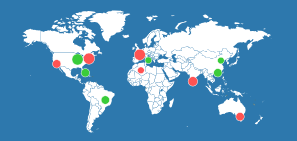Identification of electromyographic signals using machine learning techniques and low-cost technologies
Resumo
The human-robot interface (HRI) has recently become a widely studied research topic. This topic addresses the acquisition, processing and interpretation of electrobiological signals from different parts of the human body and the application of these signals for the control of robotic systems. The HRI is essential for applications involving people with disabilities, professionals working in hazardous environments, and even robotic surgery. The focus of this work is the identification of electromyographic (EMG) signals. EMG sensors were placed on specific regions of a person’s arm, and gesture recognition was performed. Initially, the EMG sensors and microcontroller were determined using low-cost technologies. Posteriorly, machine learning techniques were applied for gesture recognition. The main contributions of the work were the use of an EMG sensor commercially available in Brazil and in several countries, easily accessible and little explored in the literature, besides the use of feature extraction and machine learning techniques applications from the Matlab software, which are practical and efficient tools, and also little explored in the literature. The resulting machine learning model was quite accurate and can be applied in the future for the control of robotic systems.
Referências
Abayasiri, R. A. M., Jayasekara, A. G. B. P., Gopura, R. A. R. C., & Kiguchi, K (2021). EMG based controller for a wheelchair with robotic manipulator. Proceedings of the 3rd International Conference on Electrical Engineering (EECon), Colombo, Sri Lanka, 125-130. https://doi.org/10.1109/EECon52960.2021.9580949
Ali, M., Riaz, A., Usmani, W. U., & Naseer, N. EMG based control of a quadcopter (2020). Proceedings of the International Conference on Mechanical, Electronics, Computer, and Industrial Technology (MECnIT), Medan, Indonesia, 250-253. https://doi.org/10.1109/MECnIT48290.2020.9166603
Barsotti, M., Dupan, S., Vujaklija, I., Dosen, S., Frisoli, A., & Farina, D (2019). Online finger control using high-density EMG and minimal training data for robotic applications. IEEE Robotics and Automation Letters, 4(2), 217-223. https://doi.org/10.1109/LRA.2018.2885753
Bisi, S., De Luca, L., Shrestha, B., Yang, Z., & Ghandi, V (2018). Development of an EMG-controlled mobile robot. Robotics, 7(3), 1-13. https://doi.org/10.3390/robotics7030036
Chen, X., Li, Y., Hu, R., Zhang, X., & Chen, X (2021). Hand gesture recognition based on surface electromyography using convolution neural network with transfer learning method. IEEE Journal of Biomedical and Health Informatics, 25(4), 1292-1304. https://doi.org/10.1109/JBHI.2020.3009383
Coppeliasim (2025, August 28). CoppeliaSim Simulator. https://www.coppeliarobotics.com
Eletrogate (2025, August 28). EMG sensor. https://www.eletrogate.com/modulo-sensor-eletromiografico-de-sinal-muscular-emg
Ferreira, A., Celeste, W. C., Cheein, F. A., Bastos-Filho, T. F., Sarcinelli-Filho, M., & Carelli, R (2008). Human-Machine interfaces based on EMG and EEG applied to robotic systems. Journal of Neuroengineering and Rehabilitation, 5(10), 1-15. https://doi.org/10.1186/1743-0003-5-10
Fu, M., Xue, J., Huang, P., Chen, Z., Wei, W., Li, G., & Chen, S (2018). Research on recognition of forearm sEMG signal based on different motion modes. Proceedings of the IEEE International Conference on Cyborg and Bionic Systems (CBS), Shenzhen, China, 581-584. https://doi.org/10.1109/CBS.2018.8612195
Godoy, R. V., Dwivedi, A., Guan, B., Turner, A., Shieff, D., & Liarokapis, M (2022). On EMG based dexterous robotic telemanipulation: assessing machine learning techniques, feature extraction methods, and shared control schemes. IEEE Access, 10, 99661-99674. https://doi.org/10.1109/ACCESS.2022.3206436
Godoy, R. V., Lahr, G. J. G., Dwivedi, A., Reis, T. J. S., Polegato, P. H., Becker, M., Caurin, G. A. P., & Liarokapis, M (2022). Electromyography-Based, robust hand motion classification employing temporal multi-channel vision transformers. IEEE Robotics and Automation Letters, 7(4), 10200-10207. https://doi.org/10.1109/LRA.2022.3192623
Jun, J., Zhao, B., Zhang, P., Guo, W., & Fang, P (2021). UAV formation flight control by using the surface electromyography signals. Proceedings of the 33rd Chinese Control and Decision Conference (CCDC), Kunming, China, 3287-3291. https://doi.org/10.1109/CCDC52312.2021.9602378
Liao, L. Z., Tseng, Y. L., Chiang, H. H., & Wang, W. Y (2018). EMG-Based control scheme with SVM classifier for assistive robot arm. Proceedings of the International Automatic Control Conference (CACS), Taoyuan, Taiwan. https://doi.org/10.1109/CACS.2018.8606762
Luo, J., Lin, Z., Li, Y., & Yang, C (2020). A teleoperation framework for mobile robots based on shared control. IEEE Robotics and Automation Letters, 5(2), 377-384. https://doi.org/10.1109/LRA.2019.2959442
Maeda, Y., & Ishibashi, S (2017). Operating instruction method based on EMG for omnidirectional wheelchair robot. Proceedings of the 17th World Congress of International Fuzzy Systems Association and International Conference on Soft Computing and Intelligent Systems (IFSA - SCIS), Otsu, Japan. https://doi.org/10.1109/IFSA-SCIS.2017.8023339
Marcheix, B., Gardiner, B., & Coleman, S (2019). Adaptive gesture recognition system for robotic control using surface EMG sensors. Proceedings of the IEEE International Symposium on Signal Processing and Information Technology (ISSPIT), Ajman, United Arab Emirates. https://doi.org/10.1109/ISSPIT47144.2019.9001765
Meattini, R., Benatti, S., Scarcia, U., De Gregorio, D., Benini, L., & Melchiori, C (2018). An SEMG-based human-robot interface for robotic hands using machine learning and synergies. IEEE Transactions on Components, Packaging and Manufacturing Technology, 8(7), 1149-1158. https://doi.org/10.1109/TCPMT.2018.2799987
Montoya, B. N., Añazco, M. V., Avila, A. S., Loayza, F. R., Añazco, E. V., & Teran, E (2022). Supervised machine learning applied to non-invasive EMG signal classification for an anthropomorphic robotic hand. Proceedings of the IEEE Andean Conference (ANDESCON), Barranquilla, Colombia. https://doi.org/10.1109/ANDESCON56260.2022.9989874
Morais, G. D., Neves, L. C., Masiero, A. A., & Castro, M. C. F (2016). Application of Myo Armband system to control a robot interface. Proceedings of the 9th International Joint Conference on Biomedical Engineering Systems and Technologies (BIOSTEC), Rome, Italy, 227-231. https://doi.org/10.5220/0005706302270231
Myoware (2025, August 28). Myoware 2.0. https://www.sparkfun.com/myoware
Pololu (2025, August 28). Muscle sensor V3. https://www.pololu.com/file/0J745/Muscle_Sensor_v3_users_manual.pdf
Tello (2025, August 28). Tello quadcopter. https://www.ryzerobotics.com/tello
Yánez, A. J., Benalcázar, M. E., & Maldonado, E. M (2020). Real-Time hand gesture recognition using surface electromyography and machine learning: a systematic literature review. Sensors, 20(9), 1-36. https://doi.org/10.3390/s20092467
Copyright (c) 2025 Jhenifer July Sousa de Almeida, Caio Igor Gonçalves Chinelato

This work is licensed under a Creative Commons Attribution 4.0 International License.

Todos os trabalhos publicados na REGRASP estão licenciados sob a Creative Commons Atribuição 4.0 Internacional (CC BY 4.0).
Isso significa que:
-
Qualquer pessoa pode copiar, distribuir, exibir, adaptar, remixar e até utilizar comercialmente os conteúdos publicados na revista;
-
Desde que sejam atribuídos os devidos créditos aos autores e à REGRASP como fonte original;
-
Não é exigida permissão adicional para reutilização, desde que respeitados os termos da licença.
Esta política está em conformidade com os princípios do acesso aberto, promovendo a ampla disseminação do conhecimento científico.










.png)




























